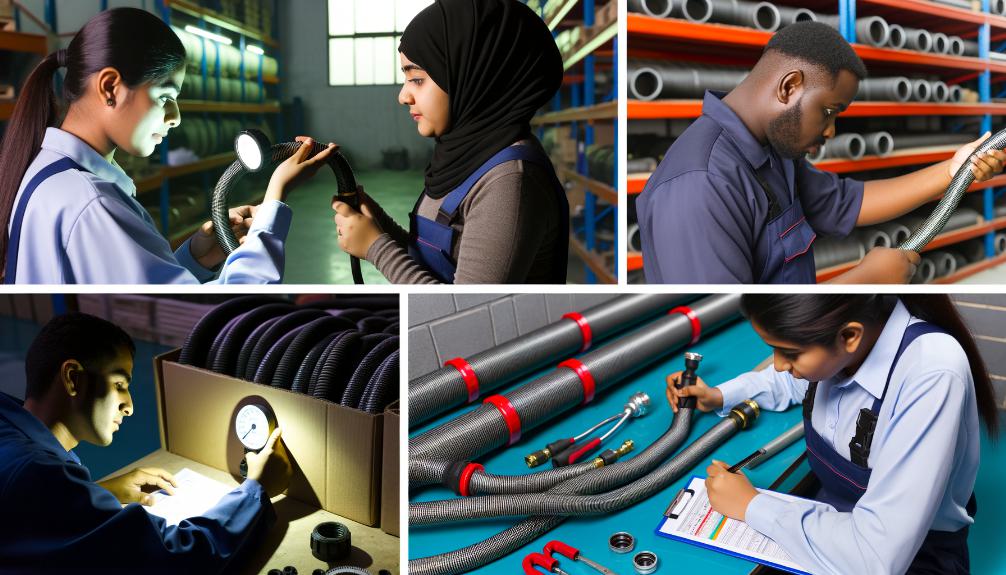
To improve your flexible hose assembly, start by selecting the right materials that match the chemical and thermal demands of your usage. PTFE or EPDM are excellent for chemical resistance, while silicone or fiberglass fares well with high temperatures. Next, install hoses correctly by following bending radius specifications and avoiding sharp bends. Secure them to minimize vibration and environmental impact. Finally, establish a routine maintenance program. Regular inspections should focus on wear, damage, or corrosion, and include pressure tests to check for leaks. By following these practices, you'll set the stage for more detailed insights into each area.
Selecting the Right Materials
When selecting materials for your flexible hose assembly, it's vital to consider the specific chemical, thermal, and mechanical stresses that the hose will encounter. The selection process hinges largely on two critical factors: chemical compatibility and temperature range.
Chemical compatibility is of utmost importance. You must verify that the materials chosen for both the hose liner and cover can withstand the types of chemicals they'll be exposed to. For example, if you're dealing with corrosive substances, materials like PTFE or EPDM might be suitable due to their resistance to harsh chemicals. Referring to a compatibility chart can offer guidance on which materials align best with specific chemicals.
Equally important is the temperature range. The material must perform within the specific thermal conditions it will face. If the hose is exposed to high temperatures, silicone or fiberglass might be appropriate choices, as they can handle elevated temperatures without degrading. On the other hand, for cooler operations, materials like PVC or nylon could be more suitable, providing enough flexibility and resistance at lower temperatures.
Proper Hose Installation Techniques
After selecting the appropriate materials for your flexible hose assembly, you must also guarantee that the installation techniques employed optimize its performance and longevity. Understanding the bending radius is essential; if a hose is bent beyond its rated capacity, it risks premature failure. Make sure you're aware of the minimum bending radius and adhere strictly to these specifications during installation.
The installation environment also plays a pivotal role. External factors such as temperature, chemical exposure, and mechanical stress should be considered to prevent degradation and ensure the hose performs well throughout its service life.
Here's a breakdown of key considerations:
| Factor | Consideration |
|---|---|
| Bending Radius | Never exceed the manufacturer's recommended limits. |
| Routing | Avoid sharp bends and route hoses away from hot surfaces. |
| Mechanical Stress | Secure hoses to avoid excessive vibration and movement. |
| Environmental Exposure | Protect hoses from extreme temperatures and corrosive chemicals. |
Routine Maintenance and Inspection
To guarantee your flexible hose assembly remains in peak condition, regularly inspect and maintain it according to manufacturer guidelines. This ensures not only the longevity of the hose but also the safety and efficiency of your entire system.
Start by scheduling routine inspections that focus on identifying any signs of wear, damage, or corrosion. These inspections should be thorough and cover every segment of the hose, including connections and fittings. It's important to check for any deformities, such as cracks, kinks, or loose fittings, which can greatly impair the assembly's function.
Pressure testing is an important component of your maintenance routine. Periodically, you should test the hose to its recommended pressure limit to make sure it can handle the operational demands. This test helps pinpoint weaknesses in the hose before they lead to failures.
Leak detection is another key aspect. You can employ various methods such as visual inspections, the use of soapy water applied to the surface, or more sophisticated electronic devices designed to detect leaks. Promptly addressing leaks not only prevents wastage and potential environmental hazards but also mitigates the risk of catastrophic system failures.
Adhering to these practices will significantly extend the life of your hose assembly, enhance safety, and optimize performance.
Conclusion
In summary, always make sure you're selecting materials that perfectly match your application's demands to avoid premature failures. Properly install hoses by following manufacturer guidelines and avoiding common mistakes like over-tightening and sharp bends.
Don't overlook regular maintenance and inspections; these are essential for spotting wear and potential issues before they lead to failures. By integrating these practices, you'll maximize the lifespan and efficiency of your hose assemblies, ensuring peak performance and safety in your operations.
© copyright 2024. All RIghts Reserved
